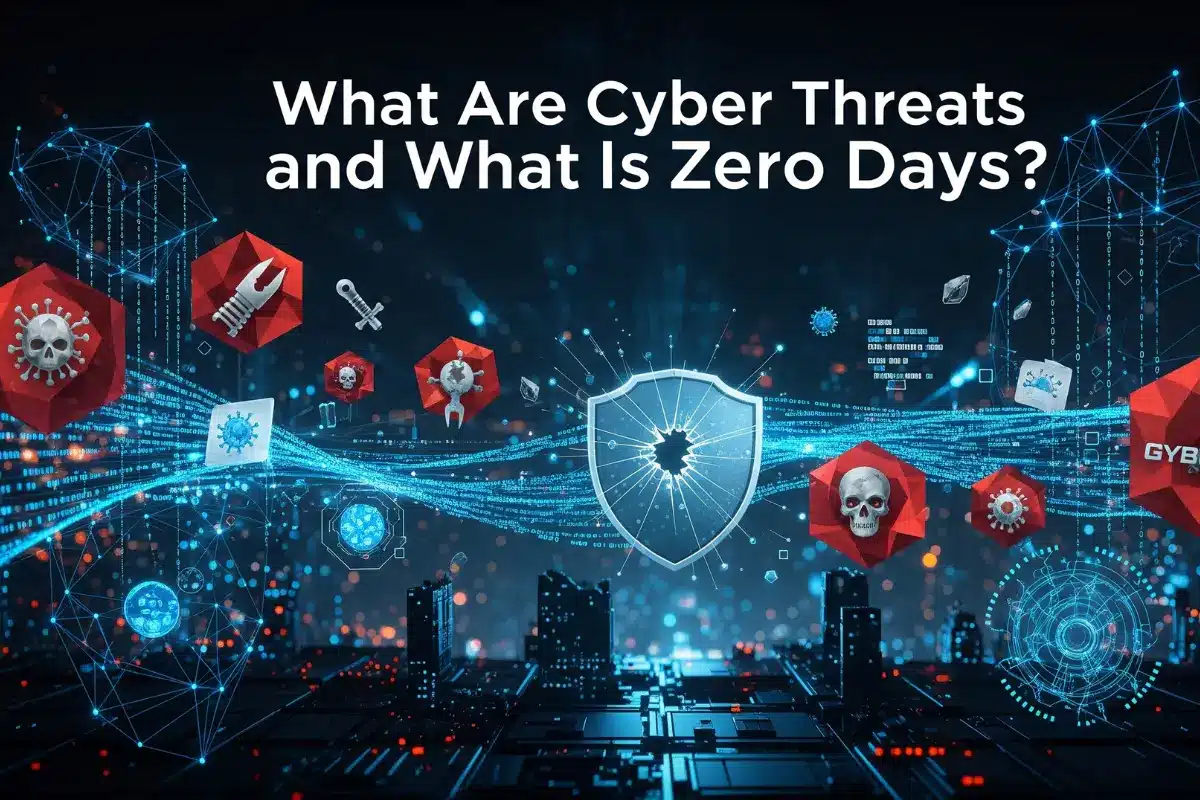Cyber threats are malicious attempts to access, damage, or disrupt computer systems, networks, or data. They include attacks like malware, phishing, ransomware, and zero-day exploits. A zero-day is a type of cyber threat that takes advantage of an unknown vulnerability in software, giving hackers a window to attack before the developer can fix it. This blog explores these threats, their impact, prevention techniques, and why cyber awareness is crucial in today’s digital world.
In today’s digital-first world, where everything from bank accounts to medical records is just a click away, cyber threats have emerged as one of the biggest modern-day challenges. Whether you’re a college student, a working professional, or a business owner in India, chances are you’ve already encountered one or more forms of cyber threat—perhaps a suspicious link on WhatsApp, a fake SMS from a “bank,” or an unfamiliar login attempt on your email.
Among the most dangerous of these threats are zero-day attacks, which take advantage of software flaws that even the software developers don’t yet know exist. But what does this all mean? How do these threats work, and more importantly, how can you protect yourself?
This blog breaks it all down in a simple, engaging way—no tech jargon, just clear answers.
What Are Cyber Threats?
Cyber threats refer to any attempt to gain unauthorized access to, damage, or disrupt digital systems, services, networks, or devices. These threats can originate from a variety of sources—cybercriminals, hackers, terrorist groups, or even nation-states.
They can target:
- Personal devices (smartphones, laptops)
- Banking systems
- Healthcare records
- Government data
- Business networks
In simpler terms: If it’s connected to the internet, it can be threatened.
Key Characteristics of Cyber Threats:
- Intentional harm: These are not accidents. They’re designed to steal, damage, or disrupt.
- Invisible: Often hard to detect until it’s too late.
- Global: Cyber threats don’t respect borders—they affect everyone.
Types of Cyber Threats You Should Know
Here are the most common types of cyber threats that Indians and global users face today:
1. Malware
Short for “malicious software,” malware includes viruses, worms, and spyware that steal data or destroy systems.
2. Phishing
Fraudulent emails or messages trick users into revealing personal information like passwords or OTPs.
3. Ransomware
Attackers lock your files and demand a ransom to unlock them. Notable in India with attacks on hospitals and government offices.
4. Denial of Service (DoS/DDoS)
Flooding a network/server with traffic to bring it down.
5. Man-in-the-Middle (MitM) Attacks
Intercepting communication between two parties to steal or alter data.
6. SQL Injection
Attackers exploit web applications to gain access to a database.
7. Zero-Day Exploits
The most dangerous type. Let’s explore this next.
What Is Zero Days in Cyber Security?
Zero-day (0-day) exploits refer to vulnerabilities in software or hardware that are unknown to the vendor. Since there’s “zero days” between discovering the flaw and the attack, no patch or solution exists at the time.
Why It’s Called Zero-Day:
Because developers have had “zero days” to fix the flaw before hackers start exploiting it.
Key Points:
- Highly valuable on the dark web
- Used in state-sponsored cyber warfare
- Difficult to detect
- Almost impossible to prevent without proactive security
Real-Life Examples of Zero-Day Attacks
1. Stuxnet (2010)
Targeted Iranian nuclear facilities by exploiting zero-day flaws in Microsoft Windows. Believed to be created by U.S. and Israeli forces.
2. Google Chrome Zero-Day (2021)
A zero-day in the V8 JavaScript engine was exploited in the wild, affecting millions globally.
3. iPhone Pegasus Spyware
Exploited zero-day vulnerabilities to spy on journalists and activists.
How Are Zero-Day Exploits Discovered?
There are two main ways:
- By ethical hackers and security researchers: Reported to the software company for a patch.
- By cybercriminals: Sold on black markets or used for personal gain.
Sources of Discovery:
| Source | Intent | Outcome |
|---|---|---|
| Ethical Hackers | Protection | Patch & Update |
| Malicious Hackers | Exploitation | Data theft, system damage |
How to Protect Yourself from Cyber Threats
Even though cyber threats, especially zero-days, are hard to prevent, you can still stay relatively safe by following some best practices:
Cyber Hygiene Tips:
- Keep all software and OS updated
- Use antivirus and endpoint security tools
- Enable firewalls
- Avoid clicking unknown links or attachments
- Use strong, unique passwords
- Enable two-factor authentication (2FA)
- Regularly back up your data
Cyber Threats vs Cyber Attacks – What’s the Difference?
| Feature | Cyber Threats | Cyber Attacks |
|---|---|---|
| Definition | Potential dangers | Actual actions taken |
| Nature | Warning signs | Execution of threats |
| Examples | Malware, Phishing | Ransomware attack, DDoS |
| Preventable? | With good practices | Harder once started |
Cyber Security in India – What’s Being Done?
The Government of India is ramping up efforts through:
- CERT-In (Indian Computer Emergency Response Team)
- National Cyber Coordination Centre (NCCC)
- Digital India Cyber Awareness Campaigns
- Data Protection Bill and IT Laws
Challenges Faced in India:
- Lack of awareness among rural users
- Increasing mobile internet users with minimal protection
- Limited cybersecurity professionals
Cyber Threats and Associated Prevention Tools
| Threat Type | Description | Prevention Tool |
|---|---|---|
| Malware | Software that harms | Antivirus, Anti-malware |
| Phishing | Fake messages/emails | Email filters, Training |
| Ransomware | Encrypts files | Backups, Endpoint Protection |
| Zero-Day | Unknown flaw | Threat intelligence, Firewalls |
FAQs
1. What are cyber threats in simple terms?
Cyber threats are harmful attempts by hackers or criminals to steal data, disrupt systems, or damage digital infrastructure.
2. What is zero days in cyber security?
A zero-day is a vulnerability in software that’s unknown to the vendor and exploited by attackers before a fix is available.
3. How can I protect myself from cyber threats?
Update software regularly, use strong passwords, avoid suspicious links, and enable two-factor authentication.
4. Are zero-day attacks preventable?
They are hard to prevent, but advanced threat detection systems and regular patching reduce the risk.
5. What does cyber security protect?
It protects devices, networks, software, and data from unauthorized access and attacks.
6. Why are zero-day exploits dangerous?
Because they are used before the public or vendors are aware, offering no time to defend against them.
7. Who creates zero-day threats?
They can be created by cybercriminals, state actors, or discovered unintentionally by researchers.
8. Is cyber threat the same as cybercrime?
Not exactly. A cyber threat is the potential, while cybercrime is the act.
9. Does India face zero-day attacks?
Yes. Critical infrastructure like banking and telecom has been targeted in the past.
10. Can antivirus stop zero-day attacks?
Only if it uses advanced detection like behavior analysis or AI-driven tools.
Conclusion
Cyber threats are real, evolving, and closer to your digital life than you might think. From email phishing to dangerous zero-day exploits, staying aware is the first step to staying safe. The key is not to panic—but to be prepared.
Start by practicing cyber hygiene, staying updated, and educating others around you. After all, cybersecurity is everyone’s responsibility.
Got questions about cyber threats or zero-day vulnerabilities? Drop them in the comments or share this post with someone who needs to read it!



